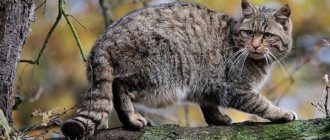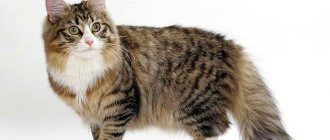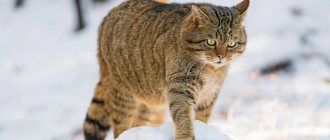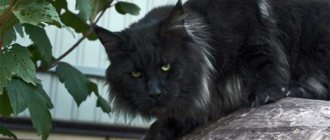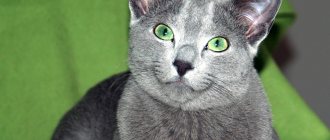The Amur forest cat (Prionailurus bengalensis euptilurus) belongs to the subspecies of the Bengal cat. It is considered a relative of the Amur tiger and the Far Eastern leopard. However, unlike its brothers, the Far Eastern cat was undeservedly deprived of attention.
Amur forest cat: description of the species
Cold indifference to this harmless animal has led to disappointing consequences - now the Amur cat is listed in the Red Book as an endangered subspecies. Thanks to the efforts of animal rights activists, in recent years the situation has leveled out - the population size is gradually increasing.
History of the species
Most likely, this species, a distant relative of the Bengal cat, lived in the Far East for a long time. But the first mentions and descriptions of the animal appeared only in 1871. These records are associated with the export of Amur forest cat skins to Chinese provinces.
Today, the Amur cat is classified as a genus of Oriental cats and a species of Bengal (described as a subspecies). The Latin name is Prionailurus bengalensis euptilurus.
Nutrition
The food of wild cats is very diverse.
The main diet is:
- field mice;
- shrews;
- muskrats;
- birds whose nests are located close to the surface of the earth;
- fish;
- snakes.
Wild cats do not form packs, but even one cat can afford to hunt animals of equal or larger weight:
- rabbits;
- martens;
- roe deer
Where does it live?
The habitat of the Far Eastern cat is quite wide. In Russia, it can be found on the coast of the Sea of Japan, in the lowlands of the Amur River and the adjacent taiga.
But it is also known in China, Japan, Korea, and the Malay Islands. Individuals are found very often near Lake Khanka - on the border of the Primorsky Territory and the border Chinese province of Heilongjiang. In addition, migrations of the Amur forest cat to the regions of Indonesia, Java, Sumatra, Burma and Nepal have been noted.
It is surprising that representatives of the species easily adapt to life in a tropical climate and in the conditions of the Ussuri taiga.
Habitats
This animal prefers remote places where no human foot can tread. It can be found in forests where there is dense undergrowth or high in the mountains where there are not many other animals.
Also, a forest cat will not live in areas where there is a lot of snow in winter, and it lies in a thick layer, because in this case, they will not be able to get food for themselves. In winter, in severe cold, it can be found near people's homes. The tailed one comes to get food.
Mr. Cat recommends: appearance features
The Amur cat is a small predatory mammal of the feline order, slightly larger than an ordinary domestic cat. The average weight of an individual is about 7 kg, although the largest representatives of the species reach 15.
A cat's weight fluctuates significantly and depends on the time of year, especially in cold climates. By the end of winter, the individual is usually extremely thin; by the beginning of autumn, after the end of the hunting season, it has significant reserves of subcutaneous fat.
The maximum body length is 90 cm, the tail is quite short - about 40 cm, height at the withers is about 40 cm.
But the size of the Amur forest cat varies significantly depending on its habitat and natural climatic conditions in its habitat.
The predator has a small elongated head with deep and fairly close-set large almond-shaped eyes. The ears are medium in size, set wide and oblique, slightly tilted forward. Their tips are rounded and there are no tassels on them. On the back surface of the auricle there are “false” eyes, like all wild cat species. It is along these white markings that the brood follows the mother in the dark.
The nose is large and wide with a protruding nose from pink to brick-brown. The cheeks are well developed, hiding powerful jaws with fairly long and strong teeth.
The preview of this video is Pallas's cat! But the video is really about the Far Eastern cat.
By the way, here is this handsome guy in the photo:
The paws of the Far Eastern cat are of medium length, strong and muscular, with pads with edging between the toes and short, but very strong and sharp claws that are easily retracted.
The skin of the Far Eastern cat has very long fur - about 5 cm. Its color can range from dirty yellow to dark brown. It also changes depending on the season of the year - in winter it gets lighter (and the undercoat thickens), in summer it gets darker. Molting usually occurs twice a year - in the off-season.
The color of the Far Eastern cat was formed for better camouflage in its habitats and for the most part protects the animal well in the Ussuri taiga.
The main color of the coat is much lighter than the dark stripes on the head, back, paws and tail, which always has a black tip.
The chin and belly are usually white. There are clear spots on the abdomen, which are always characteristic of the tabby color. On the neck and chest there is usually a “necklace” of several, up to five, red rings. There are also spots among the stripes on the sides and back. Their number depends on age - the younger the predator, the fewer there are.
Due to the rather long undercoat, the spots do not have clear boundaries. That is why in China they are called “cash”, and in shape they resemble the coins of this country.
The fur pattern of young individuals is bright, leopard-print; with age it becomes more faded and inconspicuous.
Amur forest cat (Far Eastern, leopard): description of the breed, lifestyle and character
The Amur forest cat is a mammal, a predatory animal of the cat family. This breed is closely related to the Bengal (Asian) cat. The second name of the Amur forest cat is “leopard”. He received it due to his color, similar to that of a leopard.
Relatives of the Amur forest cat live in warm regions. Surprisingly, his ancestors ended up in the taiga. This is also explained by the fact that, perhaps, it was once much warmer here than it is now. After the polar reversal and cold snap, these amazingly beautiful cats had to somehow adapt to the harsh climatic conditions of Russia.
On the territory of Russia, the wild cat lives in the Far East, in the Amur region and the Ussuri region. Outside the Russian Federation, it settles on the coast of the Sea of Japan, in China and the Hindustan Peninsula.
The forest cat's habitat is the bush thickets of river valleys, lakeside reed thickets, and low foothills overgrown with mixed forest. Usually the Amur cat does not climb high into the mountains. It tolerates cold, harsh winters well, but is completely unsuited to life in snowy areas.
Representatives of the Amur forest cat breed are the smallest among Asian cats. According to the description of the breed and appearance, they are no different from domestic pets:
- The weight of an adult varies from 4 to 8 kg.
- The body is strong and muscular. Its length, including its tail, is approximately one meter.
- The head is small in size and has an elongated shape.
- The eyes are large, deep-set and located at a short distance from each other.
- The ears are rounded in shape.
- The powerful paws of this animal are longer than those of a domestic cat, and are equipped with short and strong claws.
The fur of the Amur forest cat is very thick and soft. The color can have different variations from gray-sand to yellow-brown. Oval reddish spots are scattered throughout the body. They may have a vague or clear outline. Thanks to these spots, similar to ancient Chinese coins, it is called the “money cat” in China. Three distinct stripes run along the back, several more stripes run along the throat and chest, and two more light stripes run along the forehead.
The Far Eastern forest cat is a solitary predator, leading a nocturnal lifestyle. He is quite shy and cautious, making him very difficult to detect. When danger arises, it has the habit of climbing trees. The Amur forest cat prefers to hunt from ambush, overtaking its prey with a deft leap. It hunts well both on the ground and in trees.
The diet of a wild cat includes mouse-like rodents, squirrels, chipmunks, birds, fish and snakes. It can also handle larger animals such as hares or young roe deer. He usually hides the remains of uneaten prey by burying them in the snow, and after a while returns to finish them.
Despite their timidity and caution, severe frosts force these cats to approach human habitation and hunt rodents and poultry in old houses.
Larger representatives of the cat family live next to the wild forest cat - lynx, leopard and tiger. A meeting with them could end badly for him, so he tries to avoid them. But it is worth noting that Amur forest cats have quite a cool temperament and enormous strength for their size. Without hesitation, they are able to engage in battle with an enemy larger than them.
This representative of the cat family prefers to organize its lair in the hollows of old trees and rock crevices. He also uses old, abandoned badger and fox holes. The bottom of its home is usually covered with dry leaves and grass. In the area where the wildcat lives, there are several temporary shelters, which he visits from time to time. In harsh winters, he uses one - the safest.
People have tried to domesticate the forest cat more than once. The positive results of such experiments are very low:
- At home, the lifespan of these cats is short.
- The wild nature of the predator creates a danger for living together with other domestic animals. And he treats people with caution.
- Even if you tame a tiny newborn kitten, it will still have the desire to run away into the forest.
Habits and Habits
Although the Amur forest cat has many enemies, in its natural environment it usually lives for a very long time, up to 18 years. This animal is very careful and leads a leisurely lifestyle. Especially in taiga winter conditions, the rhythm of this predator seems to freeze. Everything is aimed at survival until the bright Far Eastern spring - metabolism slows down, blood pressure decreases.
Like most cat species, Amur forest cats are loners. The habitat of each individual is about 10 square meters. km. Animals carefully guard their territory and protect it from attacks by their fellow creatures; they do not leave it even if there is a formidable rival there - a tiger. For overnight stays, several rookeries are set up in snow-covered windfalls, abandoned burrows, and rock crevices.
In hunting, the tactics of waiting and tracking are preferred to open attack. Usually, every throw of the Amur Forest Cat is accurate and deadly.
The mating season begins in the spring, at which time pairs are formed and remain together for a long time, until the cubs become independent.
The only sounds that can be heard from these predators are the trumpet roar, which is how they call the female. In other cases, the animals are silent, even in the face of imminent danger they only hiss. Far Eastern cats have many enemies - in addition to tigers, they also include lynxes, wolves, eagle owls, owls, golden eagles, sables, wolverines, martens, and ferrets.
Predators usually do not approach human settlements, but during the rut or a particularly cold winter, this can happen.
Despite its small size, the Far Eastern cat is a dangerous shadow hunter, but it is never the first to attack a person unless it is protecting the cubs and the nest. The predator waits for its prey after sunset or in the predawn twilight.
It feeds most often on rodents, birds and small mammals. Large specimens hunt hares and medium-sized roe deer. They do not disdain snakes, badgers, and partridges, which they take great pleasure in digging out from under the snow in winter.
In summer, Amur cats eat a lot - up to 20 mice or birds per day, often hiding uneaten prey near their homes. This is due to the need to accumulate fat for the winter - a period of rare and passive hunting.
Mating usually occurs in March-April. The pair then builds a nest in a large hollow tree or under its roots. Pregnancy in a female proceeds normally - from 65 to 73 days. There are usually few kittens in a litter, from one to four.
Babies first emerge from the nest at the age of about two months. All this time, the father and mother take care of the kittens and get food for them. Then the children begin to learn the skills of hunting and independent living. By six months, the young animals leave their mother, and the couple also separates until the next rut.
Females become sexually mature by 10-12 months, males by 1.5 years.
Animal color
The wild Far Eastern cat stands out among its relatives with its thick and long fur. The villi on the body of an adult can reach 5 cm in length. This coat allows him to live in harsh climatic conditions. In the fall, the cat sheds, its fur becomes thicker and longer, and in the spring shedding occurs again.
The reddish-brown color makes the cat almost invisible among the trees. The back of the animal is darker than the belly, the color varies from gray-yellow to gray-brown. There are 3 dark brown stripes running along the cat’s spine; in some animals they merge into one wide stripe. There are 4-5 transverse thin stripes of a reddish hue on the neck. Stripes also decorate the cat's face and paws.
The long thin tail is usually plain, red or brown. However, in some representatives of the species it is colored with gray and black stripes.
Captivity
Representatives of this feline species are represented in many zoos around the world.
Predators adapt well to any conditions and reproduce well, caring for their offspring with tenderness. But they treat the person with caution and make no attempts to “make friends,” unlike, for example, the balanced and friendly Caracal.
Even in cases where the indigenous inhabitants of the Far East picked up kittens found next to their dead mother, and they were raised by a domestic cat, attempts to tame the cubs led nowhere. With the onset of puberty, the animals showed a wild disposition and had to be released or transplanted into an enclosure.
It is not safe to keep such animals in the house. But there is the possibility of partial domestication of individuals with early castration.
At the beginning of this century, an attempt was made to hybridize the Amur forest cat. The male behaved very aggressively, but the mating took place and the offspring were born. Felinologists are not sure of the need to develop a new breed based on this variety, and the purity of the species of a unique animal may suffer.
But scientists of the Siberian Branch of the Russian Academy of Sciences, on the contrary, see hybridization as the salvation for the survival of this unique species, which is disappearing from the face of the planet just before our eyes. At the same time, due to difficult natural interspecific matings, experts suggest using in vitro fertilization.
Species protection
Long years of extermination of the Far Eastern cat both in Russia and China led to almost complete extinction of the species.
Now the Amur forest cat is listed in the International Red Book as an endangered species. The population has only recently begun to grow slightly, although there is no exact data on how many of these animals there are in the world. Approximately - no more than three thousand heads. In 2004, a commemorative coin with the image of this predator was issued in Russia.
In Japan, in nature reserves and zoos, there are only about a hundred animals. There is a representative of this species in the menageries of China and Russia.
Numerous reserves are located in the Primorsky Territory of Russia - Land of the Leopard, Kedrovaya Pad, Khankaisky, Ussuriysky, Lazovsky. In the Khabarovsk Territory - Bolshekhekhiretsky.
A significant role in the almost complete disappearance of a unique cat species is played by human activity - cutting down and burning forests, plowing up virgin lands, targeted (during Soviet times) or accidental extermination. The fact is that, due to its small size, the Far Eastern cat quite often falls into traps set for hares.
The fine, even for accidentally killing an Amur forest cat, is significant. In addition, residents of areas in the habitats of the species are constantly informed about the benefits of this animal in the fight against rodents.
1111
How does it reproduce?
The Far Eastern cat is accustomed to leading a solitary lifestyle. However, with the onset of autumn, he begins to look for the female, calling her with a abrupt and loud growl. The duration of pregnancy is no more than 70 days. At the end of spring, the female brings offspring. The Ussuri kitten is born blind, its weight does not exceed 100 g. Its eyes open 2 weeks after birth. After 2 months, the kittens leave the nest and explore the territory under the supervision of the female. The father of the family also raises the offspring. After six months, the kittens leave the nest and find their own territory where they will live and hunt. Far Eastern cats reach adulthood after 1 year of life. Its duration is on average 10-12 years.
Number
The name of this animal is in the Red Book.
Far Eastern cats are incredibly secretive and cautious, so scientists have not yet been able to carry out even an approximate count of them. Despite this, not so long ago the animals were listed in the Red Book. Some are convinced that this is connected with hunting cats, but this opinion is not true. The species is in danger of extinction, as there are fewer and fewer areas suitable for their existence. In addition, burning of last year’s leaves, which is carried out every year, also poses a danger to these predators.
The Far Eastern cat is not dangerous to humans. Despite this, in the USSR it was classified as a lynx and a wolf, which could harm people. In this regard, the Amur cat was often killed for no reason in order to receive a monetary reward from the village council. Hunting for the animal was not carried out in Russia, since its fur is not of particular value. However, in the People's Republic of China it was hunted for its fur. Nowadays, killing these cats is punishable by law.
